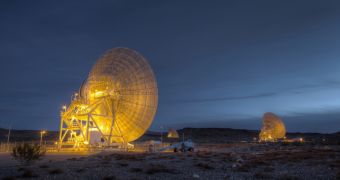On December 24, 1963, NASA started its Deep Space Network (DSN), a powerful communications array capable to sending and receiving radio signals to and from spacecraft located at the very edges of the solar system. On Christmas Ever 2013, the DSN will celebrate its 50th anniversary.
Even all these years later, the Network remains the world's largest and most powerful communications grid for talking to spacecraft in Earth's orbit, around the Moon, Mars, and other planets or asteroids, or flying freely towards the outer fringes of the solar system.
Since first commissioned, the array communicated with nearly all missions that launched from Earth to destinations such as the Moon and beyond. It is always the first installation to receive important messages, such as man's first step on the Moon, the first images of other worlds and their surfaces, and first-ever readings of the interstellar space.
Though the DSN is now a sprawling facility that features numerous way-stations, its origins were far more humble. It started out as a series of small antennas called the Deep Space Instrumentation Facility (DSIF), which was created after NASA recognized the viral importance of being able to maintain contact with its space probes, spacecraft, rovers, landers and orbiters around the solar system.
In the early 1950s, the DSIF – a precursor of the DSN – was operated by the US Army. Once NASA was founded, the facility was put under the jurisdiction of the new space agency. The official name and status change occurred on Christmas Eve, 1963.
The DSN also supported missions launched by Europe, Japan, India and Russia over the past few decades. Its capabilities were always relied upon to provide telemetry and spacecraft health data in near-real-time, depending on the distances involved.
“Today, the DSN supports a fleet of more than 30 U.S. and international robotic space missions,” explains the manager of the DSN project, Al Bhanji. The expert is based at the NASA Jet Propulsion Laboratory (JPL), in Pasadena, California.
“Without the DSN, we would never have been able to undertake voyages to Mercury and Venus, visit asteroids and comets, we'd never have seen the stunning images of robots on Mars, or close-up views of the majestic rings of Saturn,” he adds.
“In 2063, when we celebrate the Deep Space Network's 100th anniversary, we can imagine that we might be recalling the amazing days when our antennas streamed high-res video as the first humans stepped onto the surface of Mars. Or that day when we discovered a new living 'Earth' orbiting a distant star,” Al Bhanji concludes.
Happy 50th Anniversary, DSN!

 14 DAY TRIAL //
14 DAY TRIAL //